Prediction of Solar Power Using Near-Real Time Satellite Data
Abstract
:1. Introduction
2. Materials and Methods
2.1. Site Data
2.2. Satellite Data
2.3. Satellite Irradiance Forecasting Model
- Offline processing: The derivation of fitting functions against cloud index and clear sky index using historical observations.
- Image Processing: The derivation of cloud motion vectors using near real-time satellite imagery.
- Online Processing: The derivation of power ensemble using derived GHI from advected pixels after image processing.
2.3.1. Offline Processing
2.3.2. Image Processing
2.3.3. Online Processing
2.4. Evaluation Metrics
3. Results
3.1. Benchmarking
3.2. Live Predictions
3.3. Evaluations with Persistence
4. Discussion
5. Conclusions
Author Contributions
Funding
Acknowledgments
Conflicts of Interest
Appendix A
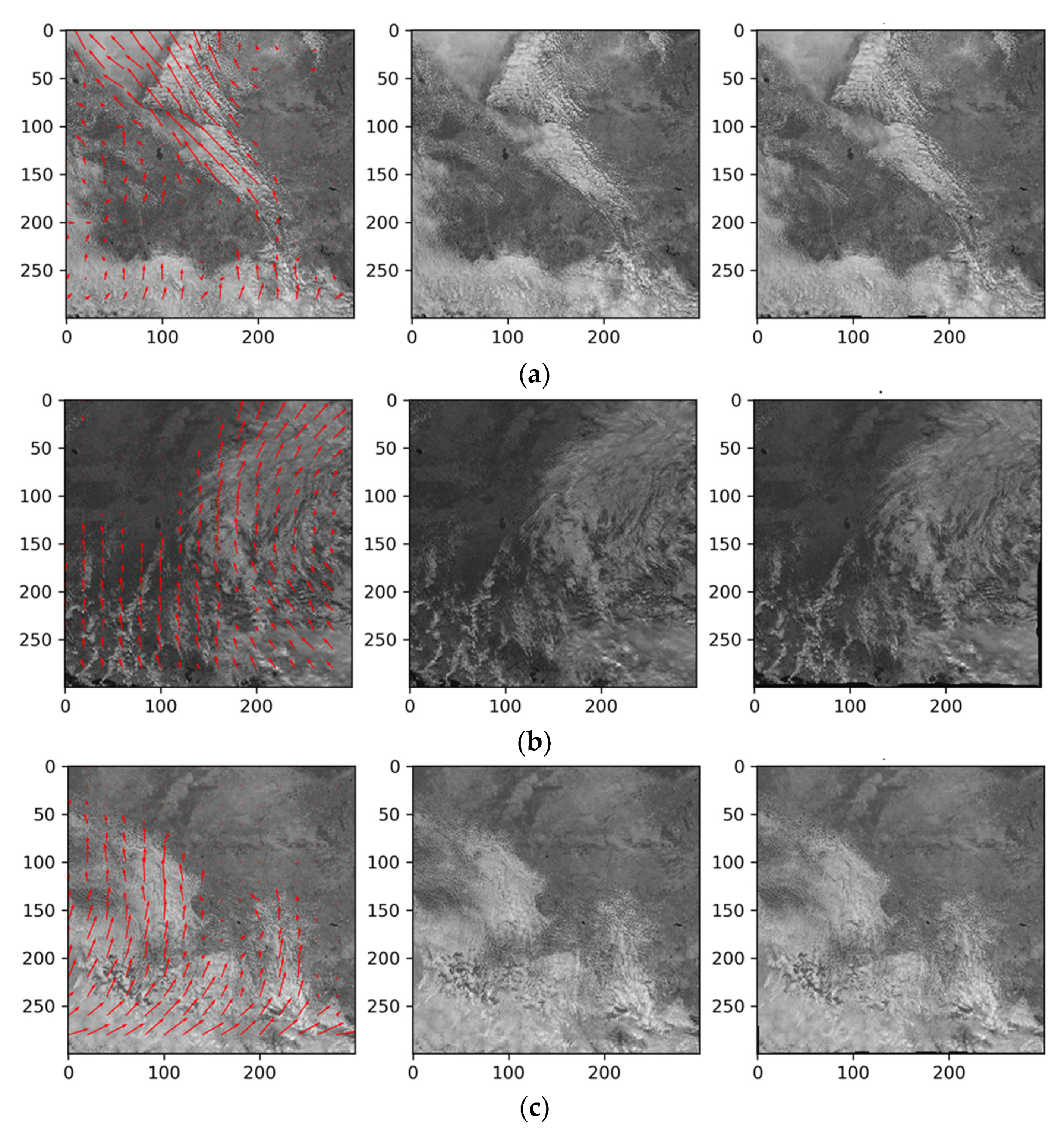
References
- International Renewable Energy Agency. Renewable Capacity Highlights: 31 March 2021; International Renewable Energy Agency: Abu Dhabi, United Arab Emirates, 2021; p. 3. Available online: https://www.irena.org/publications/2021/March/Renewable-Capacity-Statistics-2021 (accessed on 10 June 2021).
- Department of Industry Science Energy and Resources. Australian Energy Update; Australian Energy Statistics: Canberra, ACT, Australia, 2020. Available online: https://www.energy.gov.au/publications/australian-energy-update-2020 (accessed on 12 June 2021).
- Prăvălie, R.; Patriche, C.; Bandoc, G. Spatial assessment of solar energy potential at global scale. A geographical approach. J. Clean. Prod. 2019, 209, 692–721. [Google Scholar] [CrossRef]
- Prasad, A.A.; Taylor, R.A.; Kay, M. Assessment of direct normal irradiance and cloud connections using satellite data over Australia. Appl. Energy 2015, 143, 301–311. [Google Scholar] [CrossRef]
- Prasad, A.A.; Taylor, R.A.; Kay, M. Assessment of solar and wind resource synergy in Australia. Appl. Energy 2017, 190, 354–367. [Google Scholar] [CrossRef]
- Yin, J.; Molini, A.; Porporato, A. Impacts of solar intermittency on future photovoltaic reliability. Nat. Commun. 2020, 11, 4781. [Google Scholar] [CrossRef] [PubMed]
- Bevrani, H.; Ghosh, A.; Ledwich, G. Renewable energy sources and frequency regulation: Survey and new perspectives. IET Renew. Power Gener. 2010, 4, 438–457. [Google Scholar] [CrossRef] [Green Version]
- Stringer, N.; Haghdadi, N.; Bruce, A.; MacGill, I. Fair consumer outcomes in the balance: Data driven analysis of distributed PV curtailment. Renew. Energy 2021, 173, 972–986. [Google Scholar] [CrossRef]
- Sharma, V.; Aziz, S.M.; Haque, M.H.; Kauschke, T. Effects of high solar photovoltaic penetration on distribution feeders and the economic impact. Renew. Sustain. Energy Rev. 2020, 131, 110021. [Google Scholar] [CrossRef]
- Prasad, A.A.; Kay, M. Assessment of simulated solar irradiance on days of high intermittency using WRF-solar. Energies 2020, 13, 385. [Google Scholar] [CrossRef] [Green Version]
- Law, E.W.; Prasad, A.A.; Kay, M.; Taylor, R.A. Direct normal irradiance forecasting and its application to concentrated solar thermal output forecasting—A review. Sol. Energy 2014, 108, 287–307. [Google Scholar] [CrossRef]
- Miller, S.D.; Rogers, M.A.; Haynes, J.M.; Sengupta, M.; Heidinger, A.K. Short-term solar irradiance forecasting via satellite/model coupling. Sol. Energy 2018, 168, 102–117. [Google Scholar] [CrossRef]
- Law, E.W.; Kay, M.; Taylor, R.A. Evaluating the benefits of using short-term direct normal irradiance forecasts to operate a concentrated solar thermal plant. Sol. Energy 2016, 140, 93–108. [Google Scholar] [CrossRef]
- Kumar, D.S.; Yagli, G.M.; Kashyap, M.; Srinivasan, D. Solar irradiance resource and forecasting: A comprehensive review. IET Renew. Power Gener. 2020, 14, 1641–1656. [Google Scholar] [CrossRef]
- Yang, D. Ensemble model output statistics as a probabilistic site-adaptation tool for satellite-derived and reanalysis solar irradiance. J. Renew. Sustain. Energy 2020, 12, 016102. [Google Scholar] [CrossRef] [Green Version]
- Mishra, M.; Nayak, J.; Naik, B.; Abraham, A. Deep learning in electrical utility industry: A comprehensive review of a decade of research. Eng. Appl. Artif. Intell. 2020, 96, 104000. [Google Scholar] [CrossRef]
- Mayer, M.J.; Gróf, G. Extensive comparison of physical models for photovoltaic power forecasting. Appl. Energy 2021, 283, 116239. [Google Scholar] [CrossRef]
- Ahmed, R.; Sreeram, V.; Mishra, Y.; Arif, M.D. A review and evaluation of the state-of-the-art in PV solar power forecasting: Techniques and optimization. Renew. Sustain. Energy Rev. 2020, 124, 109792. [Google Scholar] [CrossRef]
- Ahmed, A.; Khalid, M. A review on the selected applications of forecasting models in renewable power systems. Renew. Sustain. Energy Rev. 2019, 100, 9–21. [Google Scholar] [CrossRef]
- Yang, D.; Kleissl, J.; Gueymard, C.A.; Pedro, H.T.C.; Coimbra, C.F.M. History and trends in solar irradiance and PV power forecasting: A preliminary assessment and review using text mining. Sol. Energy 2018, 168, 60–101. [Google Scholar] [CrossRef]
- Wang, P.; van Westrhenen, R.; Meirink, J.F.; van der Veen, S.; Knap, W. Surface solar radiation forecasts by advecting cloud physical properties derived from Meteosat Second Generation observations. Sol. Energy 2019, 177, 47–58. [Google Scholar] [CrossRef]
- Kallio-Myers, V.; Riihelä, A.; Lahtinen, P.; Lindfors, A. Global horizontal irradiance forecast for Finland based on geostationary weather satellite data. Sol. Energy 2020, 198, 68–80. [Google Scholar] [CrossRef]
- Gallucci, D.; Romano, F.; Cersosimo, A.; Cimini, D.; Paola, F.D.; Gentile, S.; Geraldi, E.; Larosa, S.; Nilo, S.T.; Ricciardelli, E.; et al. Nowcasting surface solar irradiance with AMESIS via motion vector fields of MSG-SEVIRI data. Remote Sens. 2018, 10, 845. [Google Scholar] [CrossRef] [Green Version]
- Nonnenmacher, L.; Coimbra, C.F.M. Streamline-based method for intra-day solar forecasting through remote sensing. Sol. Energy 2014, 108, 447–459. [Google Scholar] [CrossRef]
- Kim, C.K.; Kim, H.-G.; Kang, Y.-H.; Yun, C.-Y. Toward Improved solar irradiance forecasts: Comparison of the global horizontal irradiances derived from the COMS satellite imagery over the Korean Peninsula. Pure Appl. Geophys. 2017, 174, 2773–2792. [Google Scholar] [CrossRef]
- Jia, D.; Hua, J.; Wang, L.; Guo, Y.; Guo, H.; Wu, P.; Liu, M.; Yang, L. Estimations of Global Horizontal Irradiance and Direct Normal Irradiance by Using Fengyun-4A Satellite Data in Northern China. Remote Sens. 2021, 13, 790. [Google Scholar] [CrossRef]
- Yang, L.; Gao, X.; Hua, J.; Wu, P.; Li, Z.; Jia, D. Very Short-Term Surface Solar Irradiance Forecasting Based on FengYun-4 Geostationary Satellite. Sensors 2020, 20, 2606. [Google Scholar] [CrossRef]
- Yang, L.; Gao, X.; Li, Z.; Jia, D.; Jiang, J. Nowcasting of surface solar irradiance using FengYun-4 satellite observations over China. Remote Sens. 2019, 11, 1984. [Google Scholar] [CrossRef] [Green Version]
- Qin, Y.; Huang, J.; McVicar, T.R.; West, S.; Khan, M.; Steven, A.D.L. Estimating surface solar irradiance from geostationary Himawari-8 over Australia: A physics-based method with calibration. Sol. Energy 2021, 220, 119–129. [Google Scholar] [CrossRef]
- Kim, M.; Song, H.; Kim, Y. Direct short-term forecast of photovoltaic power through a comparative study between COMS and Himawari-8 meteorological satellite images in a deep neural network. Remote Sens. 2020, 12, 2357. [Google Scholar] [CrossRef]
- Hammer, A.; Heinemann, D.; Lorenz, E.; Lückehe, B. Short-term forecasting of solar radiation: A statistical approach using satellite data. Sol. Energy 1999, 67, 139–150. [Google Scholar] [CrossRef]
- Arbizu-Barrena, C.; Ruiz-Arias, J.A.; Rodríguez-Benítez, F.J.; Pozo-Vázquez, D.; Tovar-Pescador, J. Short-term solar radiation forecasting by advecting and diffusing MSG cloud index. Sol. Energy 2017, 155, 1092–1103. [Google Scholar] [CrossRef]
- Cano, D.; Monget, J.M.; Albuisson, M.; Guillard, H.; Regas, N.; Wald, L. A method for the determination of the global solar-radiation from meteorological satellite data. Sol. Energy 1986, 37, 31–39. [Google Scholar] [CrossRef] [Green Version]
- Rigollier, C.; Lefèvre, M.; Wald, L. The method Heliosat-2 for deriving shortwave solar radiation from satellite images. Sol. Energy 2004, 77, 159–169. [Google Scholar] [CrossRef] [Green Version]
- McCandless, T.; Jiménez, P.A. Examining the potential of a random forest derived cloud mask from GOES-R satellites to improve solar irradiance forecasting. Energies 2020, 13, 1671. [Google Scholar] [CrossRef] [PubMed] [Green Version]
- Yagli, G.M.; Yang, D.; Srinivasan, D. Automatic hourly solar forecasting using machine learning models. Renew. Sustain. Energy Rev. 2019, 105, 487–498. [Google Scholar] [CrossRef]
- Lago, J.; De Brabandere, K.; De Ridder, F.; De Schutter, B. Short-term forecasting of solar irradiance without local telemetry: A generalized model using satellite data. Sol. Energy 2018, 173, 566–577. [Google Scholar] [CrossRef] [Green Version]
- Ayet, A.; Tandeo, P. Nowcasting solar irradiance using an analog method and geostationary satellite images. Sol. Energy 2018, 164, 301–315. [Google Scholar] [CrossRef] [Green Version]
- Aguiar, L.M.; Pereira, B.; Lauret, P.; Díaz, F.; David, M. Combining solar irradiance measurements, satellite-derived data and a numerical weather prediction model to improve intra-day solar forecasting. Renew. Energy 2016, 97, 599–610. [Google Scholar] [CrossRef] [Green Version]
- Aguiar, L.M.; Pereira, B.; David, M.; Díaz, F.; Lauret, P. Use of satellite data to improve solar radiation forecasting with Bayesian Artificial Neural Networks. Sol. Energy 2015, 122, 1309–1324. [Google Scholar] [CrossRef]
- Marquez, R.; Pedro, H.T.C.; Coimbra, C.F.M. Hybrid solar forecasting method uses satellite imaging and ground telemetry as inputs to ANNs. Sol. Energy 2013, 92, 176–188. [Google Scholar] [CrossRef]
- Yang, D.; Li, W.; Yagli, G.M.; Srinivasan, D. Operational solar forecasting for grid integration: Standards, challenges, and outlook. Sol. Energy 2021, 224, 930–937. [Google Scholar] [CrossRef]
- Chen, R.; Wang, J.; Botterud, A.; Sun, H. Wind power providing flexible ramp product. IEEE Trans. Power Syst. 2016, 32, 2049–2061. [Google Scholar] [CrossRef] [Green Version]
- Keeratimahat, K.; Bruce, A.; MacGill, I. Analysis of short-term operational forecast deviations and controllability of utility-scale photovoltaic plants. Renew. Energy 2021, 167, 343–358. [Google Scholar] [CrossRef]
- Yang, D.; Wu, E.; Kleissl, J. Operational solar forecasting for the real-time market. Int. J. Forecast. 2019, 35, 1499–1519. [Google Scholar] [CrossRef]
- El hendouzi, A.; Bourouhou, A. Solar Photovoltaic Power Forecasting. J. Electr. Comput. Eng. 2020, 2020, 1–21. [Google Scholar] [CrossRef]
- Bessho, K.; Date, K.; Hayashi, M.; Ikeda, A.; Imai, T.; Inoue, H.; Kumagai, Y.; Miyakawa, T.; Murata, H.; Ohno, T.; et al. An introduction to Himawari-8/9—Japan’s new-generation geostationary meteorological satellites. J. Meteorol. Soc. Jap. 2016, 94, 151–183. [Google Scholar] [CrossRef] [Green Version]
- Hammer, A.; Heinemann, D.; Hoyer, C.; Kuhlemann, R.; Lorenz, E.; Müller, R.; Beyer, H.G. Solar energy assessment using remote sensing technologies. Remote Sens. Environ. 2003, 86, 423–432. [Google Scholar] [CrossRef]
- Kamath, H.G.; Srinivasan, J. Validation of global irradiance derived from INSAT-3D over India. Sol. Energy 2020, 202, 45–54. [Google Scholar] [CrossRef]
- Urbich, I.; Bendix, J.; Müller, R. A novel approach for the short-term forecast of the effective cloud albedo. Remote Sens. 2018, 10, 955. [Google Scholar] [CrossRef] [Green Version]
- Farnebäck, G. Two-frame motion estimation based on polynomial expansion. Lect. Notes Comput. Sci. 2003, 2749, 363–370. [Google Scholar]
- Ineichen, P. A broadband simplified version of the Solis clear sky model. Sol. Energy 2008, 82, 758–762. [Google Scholar] [CrossRef] [Green Version]
- Ineichen, P.; Perez, R. A new airmass independent formulation for the Linke turbidity coefficient. Sol. Energy 2002, 73, 151–157. [Google Scholar] [CrossRef] [Green Version]
- André, M.; Perez, R.; Soubdhan, T.; Schlemmer, J.; Calif, R.; Monjoly, S. Preliminary assessment of two spatio-temporal forecasting technics for hourly satellite-derived irradiance in a complex meteorological context. Sol. Energy 2019, 177, 703–712. [Google Scholar] [CrossRef]
- Yang, D.; Bright, J.M. Worldwide validation of 8 satellite-derived and reanalysis solar radiation products: A preliminary evaluation and overall metrics for hourly data over 27 years. Sol. Energy 2020, 210, 3–19. [Google Scholar] [CrossRef]
- Bright, J.M. Solcast: Validation of a satellite-derived solar irradiance dataset. Sol. Energy 2019, 189, 435–449. [Google Scholar] [CrossRef]
- Engerer, N.A.; Mills, F.P. Validating nine clear sky radiation models in Australia. Sol. Energy 2015, 120, 9–24. [Google Scholar] [CrossRef]
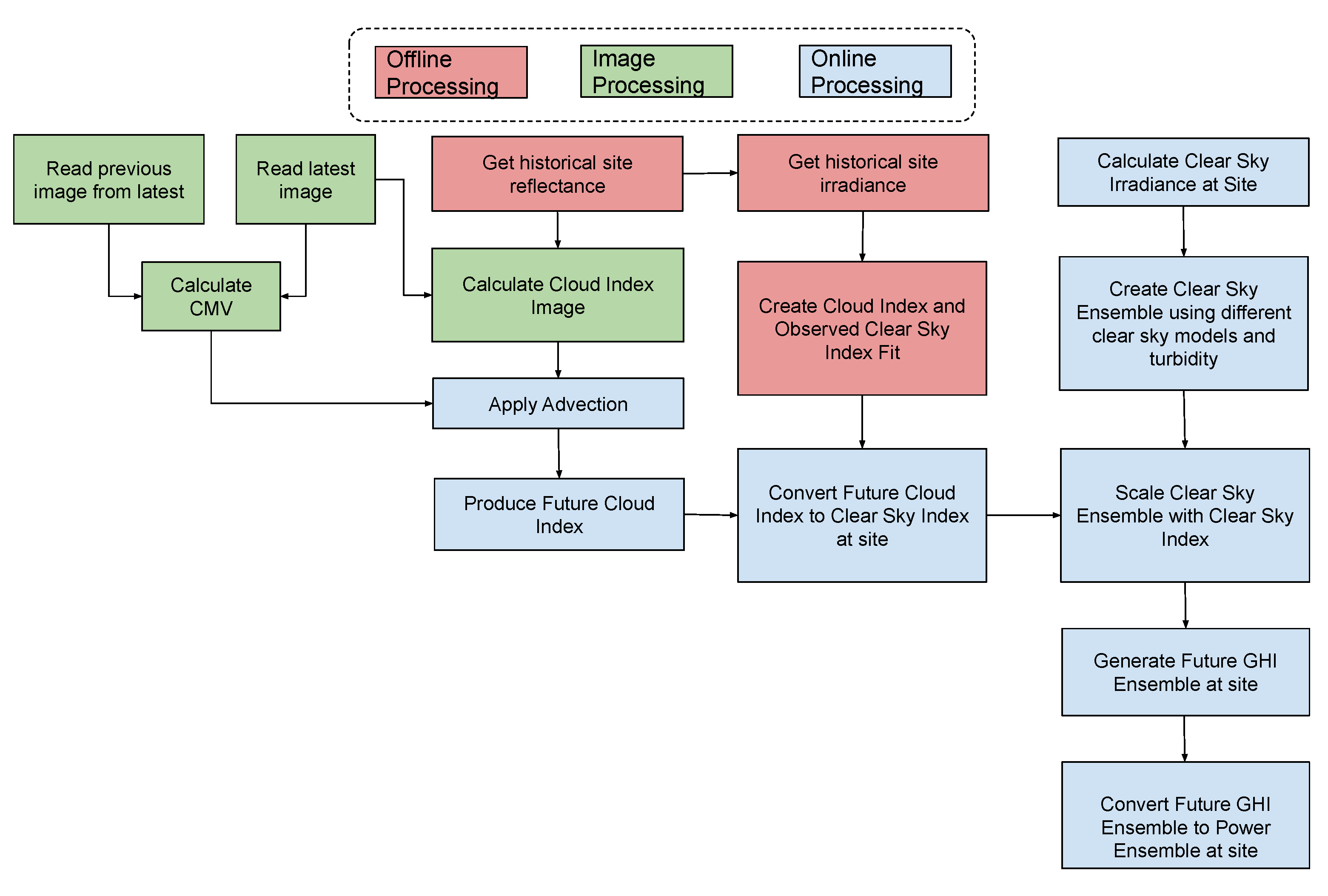
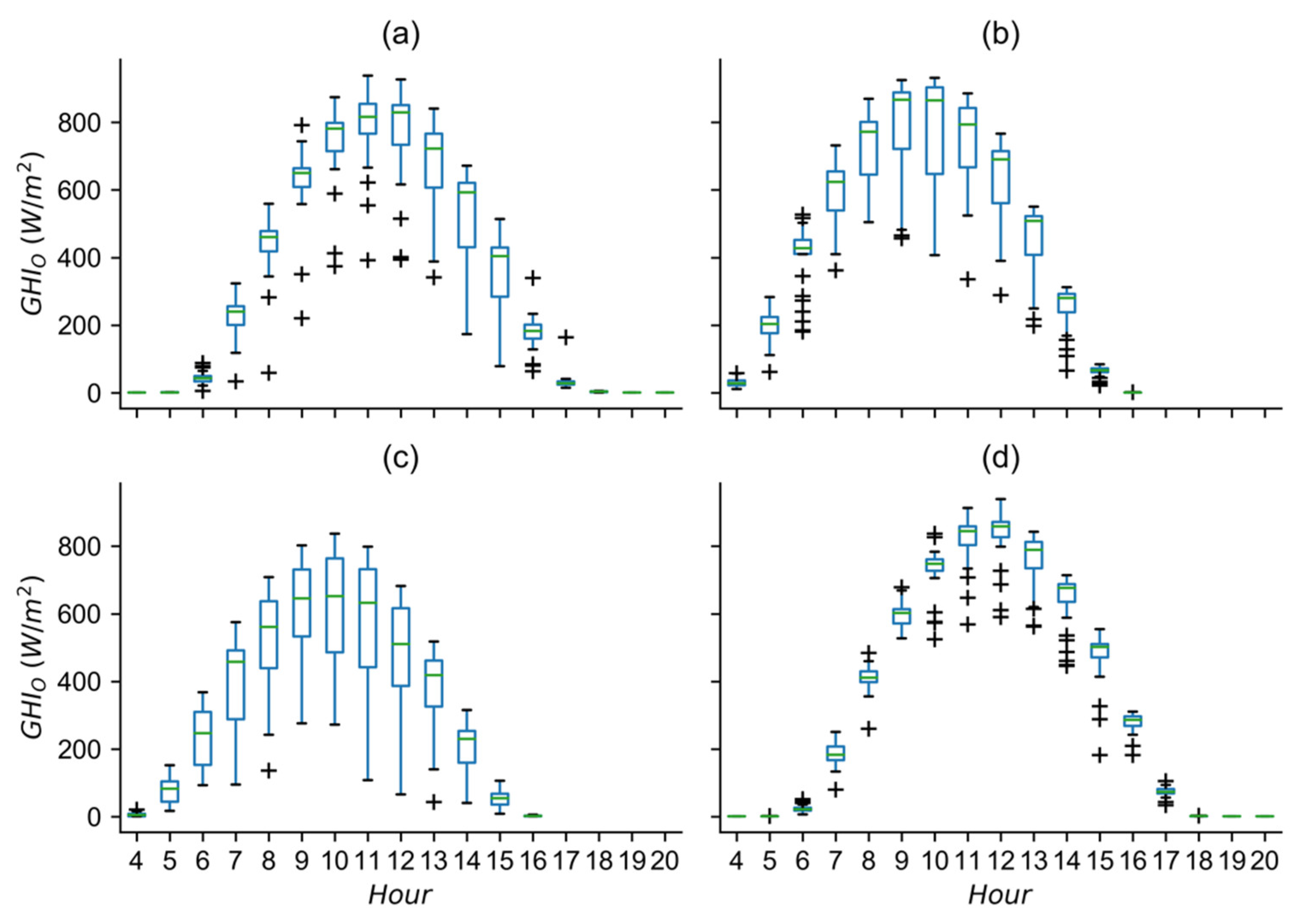


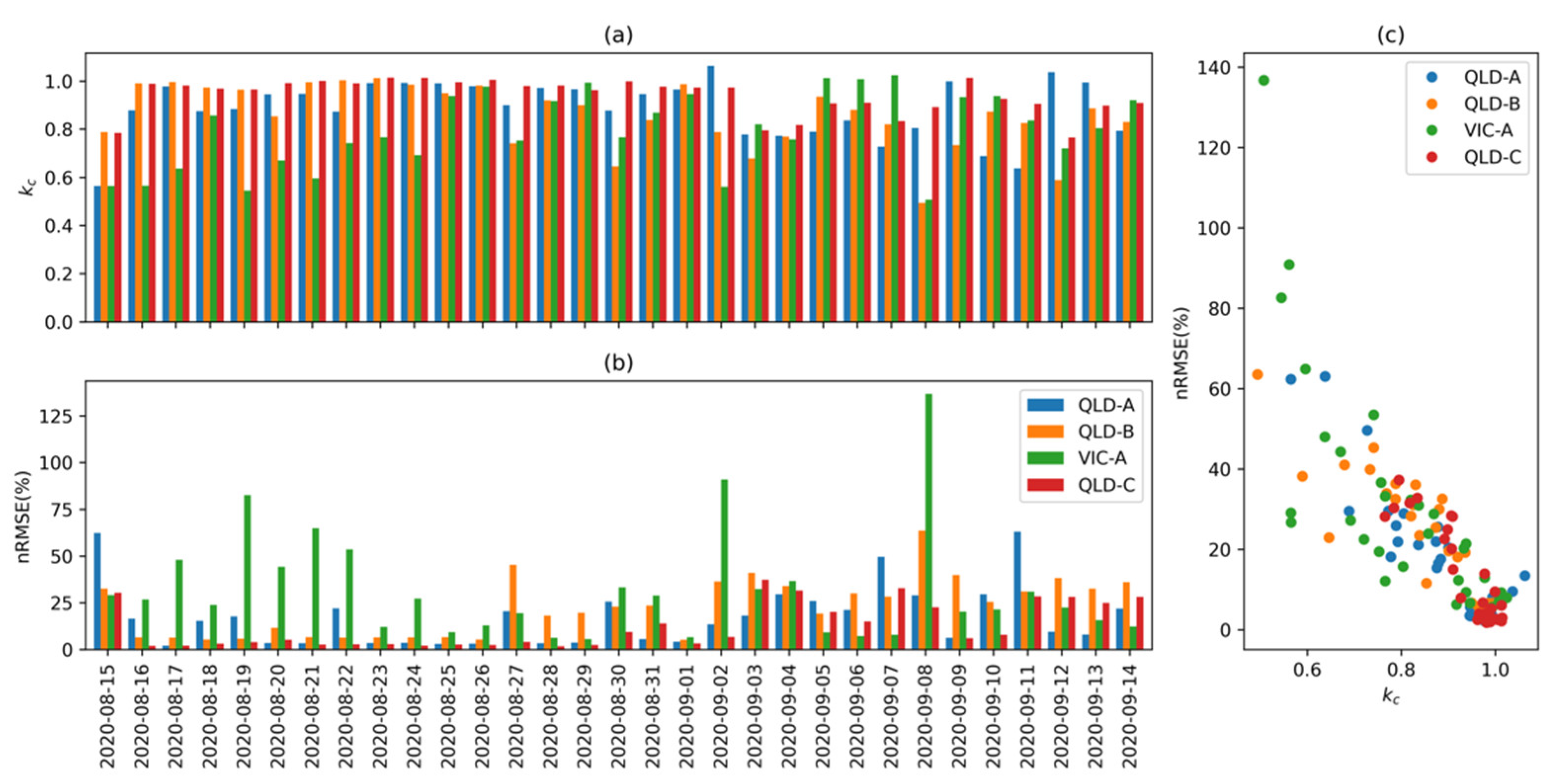
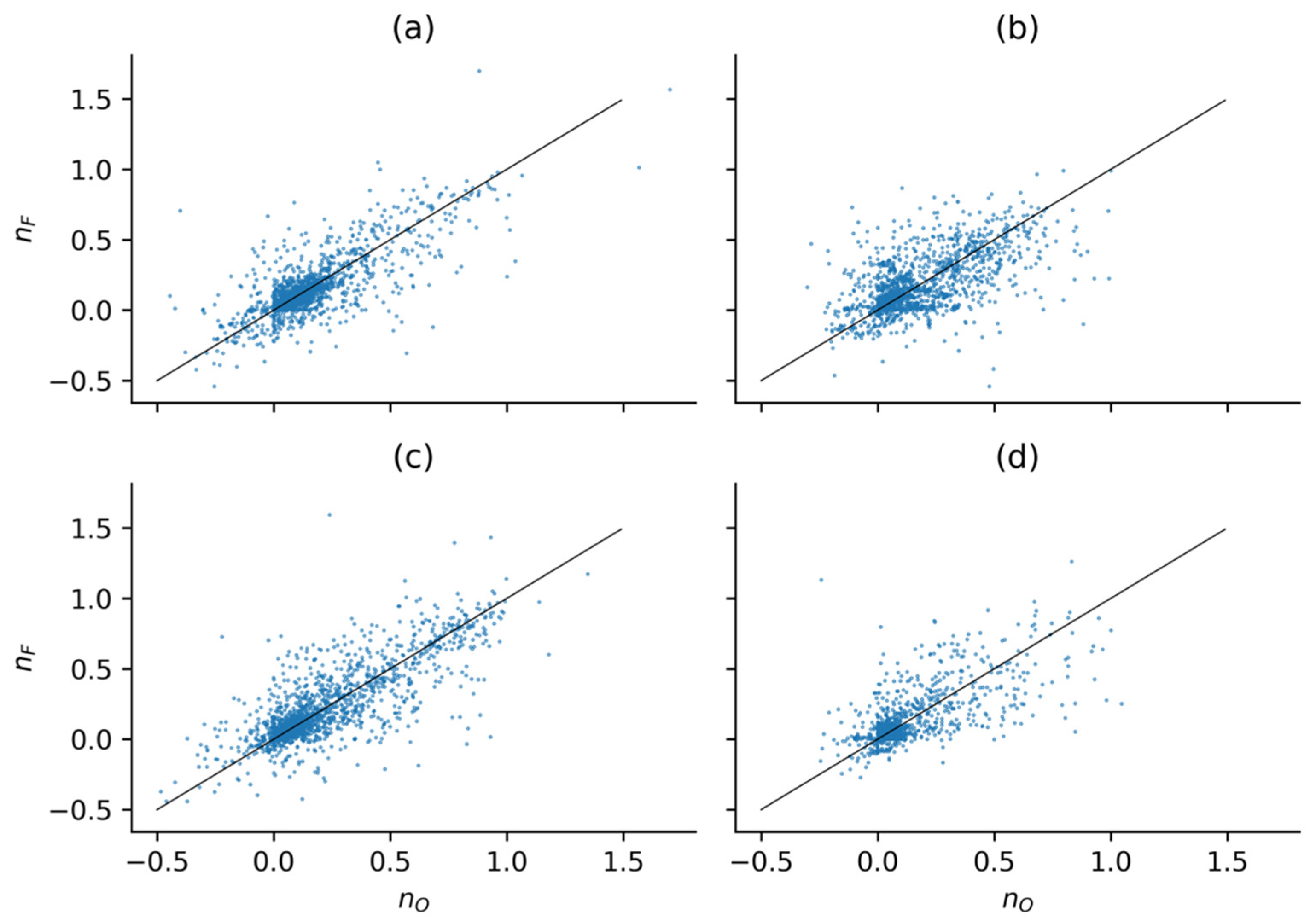
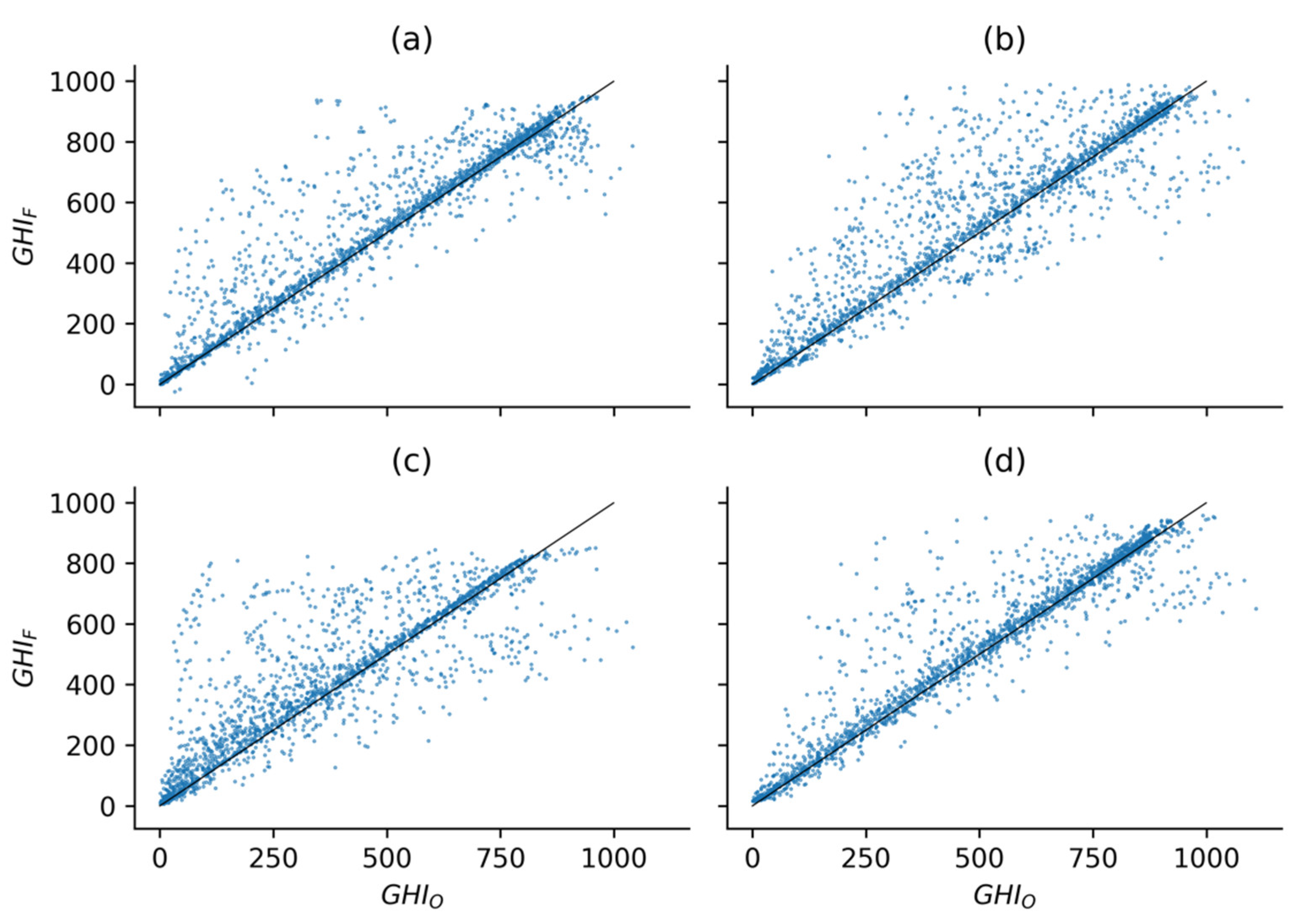
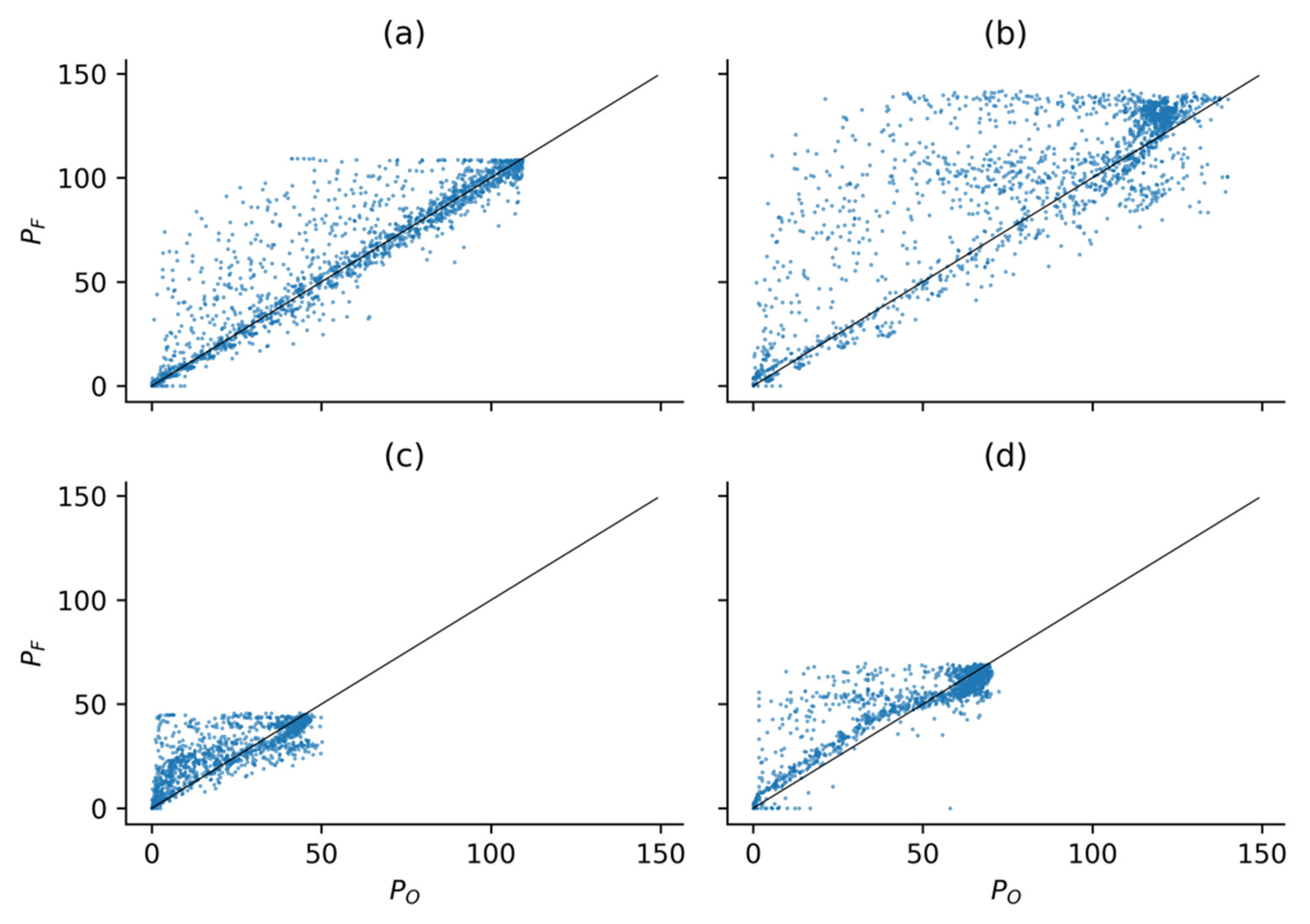
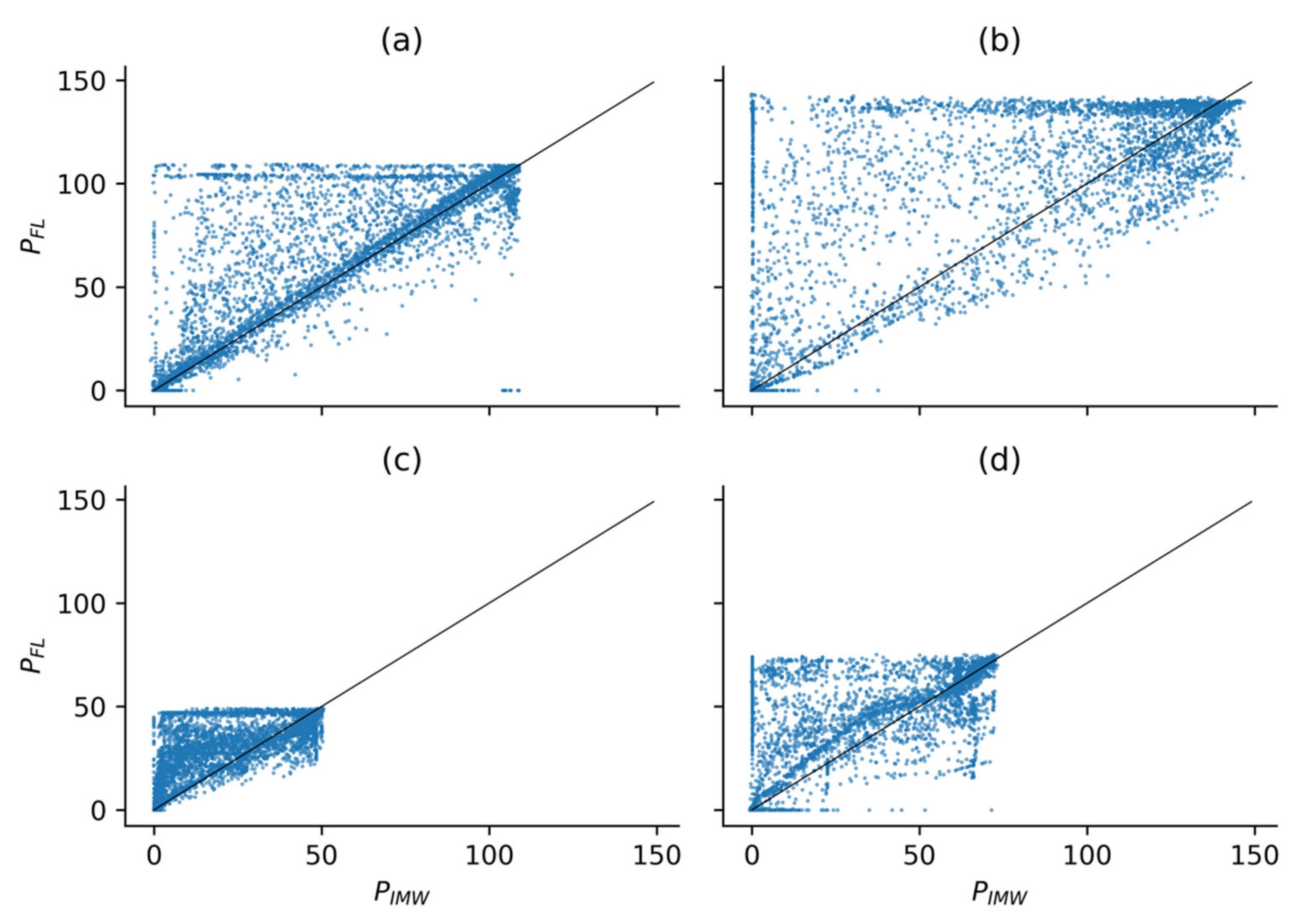
| Sites 1 | Name | Capacity (MW) | Internet | Climate |
|---|---|---|---|---|
| Queensland A | QLD-A | 110 | 4G | Humid subtropical |
| Queensland B | QLD-B | 150 | Site | Hot and humid |
| Queensland C | QLD-C | 50 | Site | Humid subtropical |
| Victoria A | VIC-A | 72 | 4G | Cold semi-arid |
| Ensemble | Clear Sky Model | Parameters |
|---|---|---|
| A | Ineichen | Climatological Turbidity |
| B | Ineichen | 1.1 × Climatological Turbidity |
| C | Ineichen | 0.9 × Climatological Turbidity |
| D | Haurwitz | Apparent Zenith Angle |
| E | Simplified Solis | Climatological Aerosol Optical Depth |
| F | Simplified Solis | 1.1 × Climatological Aerosol Optical Depth |
| G | Simplified Solis | 0.9 × Climatological Aerosol Optical Depth |
| Sites | Name | a | b |
|---|---|---|---|
| Queensland A | QLD-A | 0.32877541 | 0.75064906 |
| Queensland B | QLD-B | 0.40395545 | 0.47190695 |
| Queensland C | QLD-C | 0.13397656 | 0.70901523 |
| Victoria A | VIC-A | 0.40674933 | 0.447415 |
| Site Name | RMSE (Wm−2) | MBE (Wm−2) | MAE (Wm−2) | R2 |
|---|---|---|---|---|
| QLD-A | 92.49 (20%) | 21.03 | 47.91 | 0.90 |
| QLD-B | 113.58 (24%) | 26.41 | 65.52 | 0.84 |
| QLD-C | 78.08 (16%) | 12.66 | 38.27 | 0.92 |
| VIC-A | 118.58 (33%) | 28.78 | 62.63 | 0.77 |
| Site Name | RMSE | MBE | MAE | R2 |
|---|---|---|---|---|
| QLD-A | 0.13 | 0.07 | −0.0030 | 0.53 |
| QLD-B | 0.15 | 0.09 | 0.0002 | 0.29 |
| QLD-C | 0.11 | 0.06 | 0.0021 | 0.42 |
| VIC-A | 0.15 | 0.09 | 0.0039 | 0.61 |
| Site Name | RMSE (Wm−2) | MBE (Wm−2) | MAE (Wm−2) | R2 |
|---|---|---|---|---|
| QLD-A | 106.04 (23%) | 55.96 | 32.89 | 0.86 |
| QLD-B | 124.99 (26%) | 73.55 | 35.28 | 0.82 |
| QLD-C | 91.06 (19%) | 47.08 | 22.70 | 0.90 |
| VIC-A | 137.01(38%) | 78.59 | 39.32 | 0.71 |
| Site Name | RMSE (MW) | MBE (MW) | MAE (MW) | R2 |
|---|---|---|---|---|
| QLD-A | 14.14 (24%) | 7.44 | 4.35 | 0.85 |
| QLD-B | 28.75 (34%) | 19.35 | 14.48 | 0.49 |
| QLD-C | 11.09 (24%) | 7.07 | 3.12 | 0.76 |
| VIC-A | 10.05 (43%) | 6.69 | 3.16 | 0.62 |
| Site Name | RMSE (MW) | MBE (MW) | MAE (MW) | R2 |
|---|---|---|---|---|
| QLD-A | 18.36 (62%) | 5.38 | 7.66 | 0.77 |
| QLD-B | 40.42 (89%) | 14.92 | 19.40 | 0.48 |
| QLD-C | 23.13 (130%) | 8.47 | 11.37 | 0.23 |
| VIC-A | 10.57 (79%) | 3.76 | 5.42 | 0.63 |
| Operations | Error | QLD-A (%) | QLD-B (%) | QLD-C (%) | VIC-A (%) |
|---|---|---|---|---|---|
| GHI (Benchmarking) | err < 1% | 16 (8) | 9 (5) | 15 (16) | 10 (3) |
| err < 5% | 49 (33) | 38 (27) | 48 (38) | 33 (23) | |
| err < 10% | 63 (50) | 52 (43) | 63 (53) | 44 (39) | |
| Power (Benchmarking) | err < 1% | 12 (10) | 4 (22) | 8 (27) | 6 (15) |
| err < 5% | 43 (32) | 20 (40) | 31 (43) | 20 (32) | |
| err < 10% | 60 (48) | 43 (47) | 50 (49) | 34 (38) | |
| Power (Live Predictions) | err < 1% | 7 (5) | 2 (10) | 3 (6) | 4 (8) |
| err < 5% | 19 (9) | 14 (15) | 13 (11) | 13 (14) | |
| err < 10% | 26 (16) | 20 (20) | 18 (14) | 18 (18) |
| Operations | Error | QLD-A (%) | QLD-B (%) | QLD-C (%) | VIC-A (%) |
|---|---|---|---|---|---|
| GHI (Benchmarking) | err < 1% | 48 | 67 | 32 | 58 |
| err < 5% | 74 | 74 | 68 | 77 | |
| err < 10% | 84 | 81 | 81 | 61 | |
| Power (Benchmarking) | err < 1% | 39 | 26 | 10 | 16 |
| err < 5% | 71 | 23 | 13 | 6 | |
| err < 10% | 87 | 52 | 54 | 26 | |
| Power (Live Predictions) | err < 1% | 83 | 26 | 48 | 17 |
| err < 5% | 91 | 51 | 71 | 34 | |
| err < 10% | 91 | 54 | 80 | 54 |
Publisher’s Note: MDPI stays neutral with regard to jurisdictional claims in published maps and institutional affiliations. |
© 2021 by the authors. Licensee MDPI, Basel, Switzerland. This article is an open access article distributed under the terms and conditions of the Creative Commons Attribution (CC BY) license (https://creativecommons.org/licenses/by/4.0/).
Share and Cite
Prasad, A.A.; Kay, M. Prediction of Solar Power Using Near-Real Time Satellite Data. Energies 2021, 14, 5865. https://doi.org/10.3390/en14185865
Prasad AA, Kay M. Prediction of Solar Power Using Near-Real Time Satellite Data. Energies. 2021; 14(18):5865. https://doi.org/10.3390/en14185865
Chicago/Turabian StylePrasad, Abhnil Amtesh, and Merlinde Kay. 2021. "Prediction of Solar Power Using Near-Real Time Satellite Data" Energies 14, no. 18: 5865. https://doi.org/10.3390/en14185865
APA StylePrasad, A. A., & Kay, M. (2021). Prediction of Solar Power Using Near-Real Time Satellite Data. Energies, 14(18), 5865. https://doi.org/10.3390/en14185865







